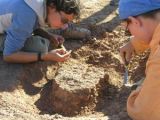A team of paleontologists from Montana and Mongolia excavated 67 dinosaurs skeleton in just one week this summer in the Gobi desert.
The varied skeletons of vegetarian Psittacosaurus - an early ancestor of the rhino-like horned dinosaurs - will give the opportunity to paleontologists to compare skeletal changes during the creature's lifespan.
The same area, a few square miles of badlands, yielded 30 skeletons last year, so researchers now have about 100 Psittacosaurus skeletons. The skeletons ranged in length from one to five feet and stood about two feet tall.
"That's what I was there for -- getting as many of those as we could possibly get," said Jack Horner from Montana State University, as he waited for the rest of the MSU team to return to Bozeman.
He looked specifically for Psittacosaurus fossils, because it was a very common dinosaur and would give him lots of specimens. It would also keep away poachers and commercial fossil hunters who work in the area, but prefer rare fossils.
Horner wants a large number of fossils, so he can compare variations between skeletons and changes during growth.
The Psittacosaurus (in old Greek "parrot lizard") was a vegetarian that lived about 130-100 million years ago in the Early Cretaceous Period. It was not a lizard, but a true dinosaur, with a kind of beak vaguely similar to that of a parrot.
"The reason I went after Psittacosaurus was because I figured I could get more of those dinosaurs in the shortest period of time than any other dinosaur", Horner added.
This summer's fossils have all been excavated and are now at the Mongolian university, Horner said. Jamie Cornish, marketing director at MSU's Museum of the Rockies, mentioned the bones belong to Mongolia, but Horner may obtain casts of them. Horner added that he will be able to study some of the fossils in Montana, but they will be returned to Mongolia.
The Mongolian dig is funded by Nathan Myhrvold and will continue next summer, Horner said. Myhrvold is a member of the Museum of the Rockies National Advisory Board and a major supporter of paleontology research in Eastern Montana.
The Mongolian project is a joint research project with Mongolia's Science and Technology University. It's also designed to help the Mongolian University develop its paleontology program for students. It will include the construction of a preparation lab and a small museum in Mongolia.
"This project is primarily for the benefit of Mongolia, looking for specimens for them to put in a museum we're going to encourage them to build," Horner said. He added that the museum project is similar to an effort at Rudyard in northern Montana.
The paleontologists found two carnivorous fossils in Mongolia in addition to the Psittacosaurus, Horner said. One of them looked like a raptor and may be a new species, but Horner said, "We find new species all the time. ... A hundred Psittacosauruses are a lot more interesting to me than new species."
Photo courtesy: Jack Horner. Liz Freedman, left, and Holly Woodward excavate a Psiitacosaurus skeleton in Mongolia. The two are Jack Horner's doctoral students at Montana State University.
"

 14 DAY TRIAL //
14 DAY TRIAL // 
